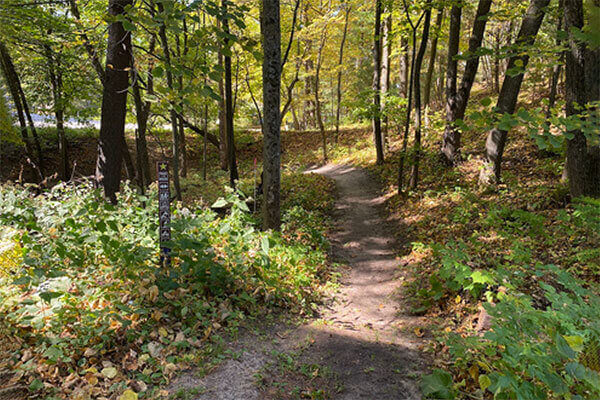What are Sustainable Trails?

A trail is a designated route for walking, biking, or other activities. Trails often traverse natural landscapes giving trail users access to nature. Not all trails are created equally.
What are sustainable trails?
“Sustainable trails” are built and maintained to modern engineering and environmental guidelines, such as the following:
- United States Forest Service (USFS) – Trail Maintenance and Construction Notebook (1)
- Minnesota Department of Natural Resources (MN DNR) – Trail Planning, Design, and Development Guidelines (2)
- American Trails – Foundations of Sustainable Trails (3)
What are the goals of sustainable trails?
Sustainable trails seek to better protect the environment while ensuring access to outdoor recreation for all. The MN DNR trail guidelines describe this on page 1.1 (pg. 8) (1):
“The guidelines emphasize the development of physically and ecologically sustainable trails that will serve the needs of users for generations to come while preserving the sense of place and protecting the surrounding environment.”
Are “sustainable trails” actually low-impact?
Yes. Many studies, across the nation and globe, have found that modern trail construction reduces environmental impacts. Here in the United States, research biologists at the U.S. Geological Survey (USGS) wanted to check whether modern guidance was improving
durability and reducing soil loss for natural-surface trails. This 2017 study (4) found that:
“…sustainably designed and well-maintained trails can substantially avoid or minimize tread soil loss, enhancing physical and managerial sustainability. The full application of these management actions should, in most instances, accommodate recreational traffic within acceptable levels of resource degradation, alleviating the need for use reduction and enhancing social sustainability.”
A study reviewing the findings of over 40 other studies concluded that mountain biking does not appear to have greater impact than other trail activities (5):
“…mountain biking on existing trails is not associated with worse environmental impacts when compared to hiking or other common activities undertaken in natural spaces.”
References & Further Information:
- United States Forest Service – Trail Maintenance and Construction Notebook: https://www.fs.usda.gov/sites/default/files/fs_media/fs_document/trail-maintenancenotebook.pdf
- MN DNR, Parks and Trails Division, Trail Planning, Design, and Development Guidelines: https://www.dnr.state.mn.us/publications/trails_waterways/tgmanual/index.html
- American Trails – Foundations of Sustainable Trails (2023), 5-part training course through Indiana University. https://www.americantrails.org/foundations-of-sustainable-trails-a-trail-from-start-to-finish-online-training
- Jeff Marion and Jeremy Wimpey – Assessing The Influence of Sustainable Trail Design and Maintenance On Soil Loss (2017): https://pubs.usgs.gov/publication/70185163
- Grapentin, Stephen, et al. (2018). How Soil, Flora and Fauna React To Mountain Bikers– An Overview of the Current State of Research. https://mountainbike-tourismusforum.de/unterlagen/Environmental%20impact%20of%20mountain%20biking.pdf
- Martin, Ross H. (2017) – THE GEOMORPHIC NATURE OF MOUNTAIN BIKE IMPACTS ONSELECTED TRAIL SYSTEMS NEAR AUSTIN, TEXAS: https://digital.library.txst.edu/server/api/core/bitstreams/aa89a8a0-2e64-406bb3c3-9ba8cdcfba8d/content
- Dementyev, Fletcher, et al. (2023) Middle school cycling program is associated with improved mental health and wellbeing in adolescents during COVID-19:
https://www.frontiersin.org/journals/sports-and-activeliving/articles/10.3389/fspor.2023.1255514/full - IMBA Trail Solutions – IMBA’s Guide to Building: https://www.imba.com/resource/trailsolutions
- Minnesota Department of Natural Resources – Trail Planning, Design, and Development Guidelines: https://www.dnr.state.mn.us/publications/trails_waterways/index.html
- Colorado’s Guide to Planning Trails with Wildlife in Mind: https://cdn2.assetsservd.host/materialcivet/production/images/documents/Planning_Trails_with_Wildlife_in_Mind_full_plan.pdf?dm=1741885420
